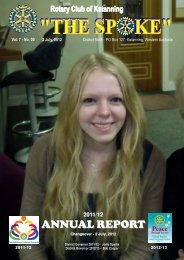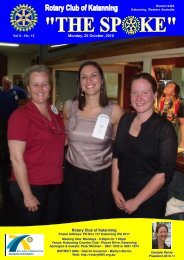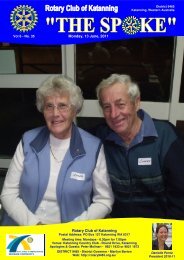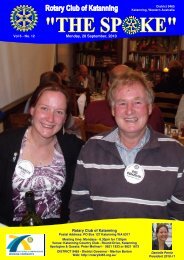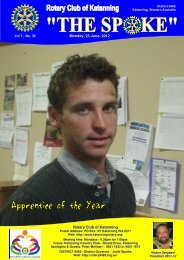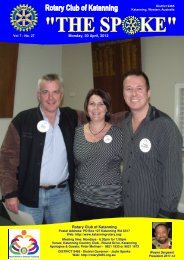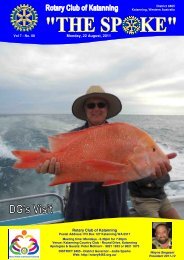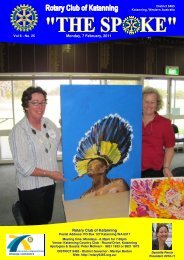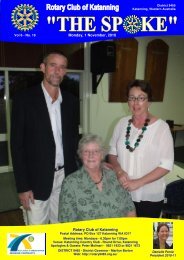Vol 7-18-Nov 14 - Katanning Rotary Club
Vol 7-18-Nov 14 - Katanning Rotary Club
Vol 7-18-Nov 14 - Katanning Rotary Club
Create successful ePaper yourself
Turn your PDF publications into a flip-book with our unique Google optimized e-Paper software.
District 9465<strong>Katanning</strong>, Western Australia<strong>Vol</strong> 7 - No. <strong>18</strong> Monday, <strong>14</strong> <strong>Nov</strong>ember, 2011<strong>Rotary</strong> <strong>Club</strong> of <strong>Katanning</strong>Postal Address: PO Box 127 <strong>Katanning</strong> WA 6317Web: http://www.katanningrotary.org/Meeting time: Mondays - 6.30pm for 7.00pmVenue: <strong>Katanning</strong> Country <strong>Club</strong> - Round Drive, <strong>Katanning</strong>Apologies & Guests: Peter Molinari - 9821 1933 or 9821 1673DISTRICT 9465 - District Governor - Jodie SparksWeb: http://rotary9465.org.au/Wayne SergeantPresident 2011-12
Monday, <strong>14</strong> <strong>Nov</strong>ember, 2011<strong>Rotary</strong> <strong>Club</strong> of <strong>Katanning</strong><strong>Club</strong> DirectorsPresident:Wayne SergeantTel: (H) 08 9821 <strong>18</strong>90(M) 0409 103 801District GovernorDistrict 9465Jodie Sparks<strong>Club</strong> Service/President ElectDavid MeyerTel: (H) 08 9821(M) 0417 178 387International ServiceNigel AitkenTel: (H) 9821 1690(M)New GenerationsJacqueline StadeTel: (H) 08 9821 1558(M)Vocational ServiceRussel ThomsonTel: (H) 08 9823 1549(M) 0419 950 217Community ServiceIian WoodsTel: (H) 98448649(M) 0428 915 815POLIO PLUSHow immunisation worksImmunisation works by tricking thebody into believing it isexperiencing a full-scale invasionby an infectious agent so that theimmune system can fortify itsdefences.During vaccination, a harmlessversion of a germ is introducedto the body and the immune systemresponds by producing antibodiesto attack the intruder.Thereafter, a memory of this“invasion” remains so that theimmune system can quickly recogniseand neutralise disease-causingagents when they appear.Today there are several types ofvaccines.Some, such as the oral poliovaccine (OPV), are live,“attenuated” vaccines which meansthe virus has been weakened sothat it stimulates antibodyproduction, but does not cause thedisease.Others such as the “whole-cell”pertussis vaccine use aninactivated, or killed, virus that stilltriggers an immune response.Tetanus toxoid (TT), the vaccinethat protects mothers and newbornsfrom tetanus, is a detoxifiedversion of the toxin (poison) thatcauses the disease.A fourth variety of vaccine, such asthat for Hemophilus influenzaetype b (Hib), uses only thecomponents of the virus or bacteriathat provoke an immune response.Mothers can pass on immunity totheir babies across the placentaduring the final months ofpregnancy.The amount of inherited immunityvaries by disease and is animportant factor in deciding when achild should be immunised.A mother's antibodies may protecta child from measles for 6 to 12months.But, in the case of diseases such aspertussis, immunity may last onlyfor a few weeks.Tetanus is one example whereinherited immunity is critical andthe mother must be immunised tooffer protection to her newborn.Immunisations teach your bodyhow to defend itself when germssuch as viruses or bacteriainvade it.They expose you to a very small,very safe amount of a virus orbacteria that has been weakened orkilled.Your immune system then learns torecognise and attack the infection ifyou are exposed to it later in life.As a result, you will either notbecome ill or have a milderinfection.This is a natural way to deal withinfectious diseases.Four different types of vaccines arecurrently available:1. Live virus vaccines use theweakened (or attenuated) form ofthe virus. The measles, mumps, andrubella (MMR) vaccine and thevaricella (chickenpox) vaccine areexamples of this type.2. Killed (inactivated) vaccines aremade from a protein or othersmall pieces taken from a virus orbacteria. Influenza shots are anexample of this type of vaccine.3. Toxoid vaccines contain a toxinor chemical made by thebacteria or virus. They make youimmune to the harmful effects ofthe infection, instead of to theinfection itself. Examples are thediphtheria and tetanus vaccines.4. Biosynthetic vaccines containhuman-made substances are verysimilar to pieces of the virus orbacteria. The Hib ( Haemophilusinfluenzae type B) conjugatevaccine is one example.Continued Page 8District 9465 - Western AustraliaPage 2OURCOVERRob Smithson (with his wife Sonia) was inductedas a member of the <strong>Rotary</strong> <strong>Club</strong> of <strong>Katanning</strong>.<strong>Rotary</strong> <strong>Club</strong> of <strong>Katanning</strong>
Monday, <strong>14</strong> <strong>Nov</strong>ember, 2011POLIO PLUSSupport for polio eradication<strong>Rotary</strong> <strong>Club</strong> of <strong>Katanning</strong><strong>Club</strong> Officers“In honour of World Polio Day, 24October, we are asking for yourhelp to tell the world about<strong>Rotary</strong>’s achievements and to finishthe job,” stated <strong>Rotary</strong> FoundationTrustee Chair Bill Boyd, inannouncing to club presidents aspecial online initiative in supportof <strong>Rotary</strong>’s US$200 MillionChallenge for polio eradication.Rotarians responded generouslyduring the 24-28 October initiative,in which the Foundation offereddouble Paul Harris Fellowrecognition points for onlinecontributions of $100 or more.Contributions are being tallied andthe total will be announced soon.Throughout the week, Rotarianstook up the call to end polio invariety of ways.In Australia, Rotarians and theGlobal Poverty Project carried out apetition drive to persuade worldleaders to fully fund the criticalwork of the Global PolioEradication Initiative.Almost 25,000 supporters signedthe petition, resulting in a $20,000contribution to <strong>Rotary</strong>'s challengeby the <strong>Rotary</strong> <strong>Club</strong> of Crawley,Western Australia, which hadoffered to donate A$1 (aboutUS$1) for each signature.In Perth, the Global PovertyProject's End of Polio Concert on28 October raised additional funds.The concert coincided with theCommonwealth Heads ofGovernment Meeting in Perth;Rotarians had teamed up with thegroup to encourage governmentAfter the Commonwealth Heads ofGovernment Meeting in Perth, thegovernments of Australia, Canada, andNigeria, along with the GatesFoundation, made a combined pledgeof more than US$100 million in newfunds for polio eradication.Standing with Canadian Rotarian andpolio survivor Ramesh Ferris (center)are Nigerian President GoodluckJonathan, Canadian Prime MinisterStephen Harper, British Prime MinisterDavid Cameron, Pakistani PrimeMinister Yousaf Raza Gilani, andAustralian Prime Minister Julia Gillard.Photo by Petina Dixon-Jenkinsleaders to put polio eradication onthe agenda.Following the meeting, thegovernments of Australia, Canada,and Nigeria, along with the Bill &Melinda Gates Foundation,announced a combined pledge ofmore than US$100 million tosupport polio eradication efforts.“I also want to acknowledge theefforts of <strong>Rotary</strong> in what has been along-standing global initiative forchange, and I'd like to remindeveryone that change is possible,”said Australian Prime MinisterJulia Gillard.“When the Queen first visited Perthin 1954, it was in the grips of apolio epidemic.Of course, circumstances havechanged in our country.”“The government of Canada isproud to have supported [theGlobal Polio Eradication Initiative]Continued on Page 6<strong>Club</strong> SecretaryKeith OhlsenTel: (H) 08 9821 4<strong>14</strong>1(M) 0427 817 008<strong>Club</strong> TreasurerMarlene ShackleyTel: (H) 08 9822 8040(M) 0428 683 601Spoke Editor/WebmasterArthur ToddTel: (H) 08 9821 2019(M) 0429 100 084Sergeants at ArmsDanny McGrathTel: (H) 08 9821 8697(M) 0427 876 117&Michael HobleyTel: (H) 08 9821 4333(M) 0428 2<strong>14</strong> 794AttendancePeter MolinariTel: (H) 08 9821 1673(W) 08 9821 1933Immediate Past PresidentDanielle PerrieTel: (H) 08 9822 8030(M) 0428 231 506Program DirectorGreg RammTel: (H) 08 9821 17<strong>18</strong>(M) 0427 974 452<strong>Rotary</strong> <strong>Club</strong> of <strong>Katanning</strong> Page 3
Meeting SummaryMonday, <strong>14</strong> <strong>Nov</strong>ember, 2011Monday, <strong>14</strong> <strong>Nov</strong>ember, 2011VENUE:<strong>Katanning</strong> Country <strong>Club</strong>, Round Drive, <strong>Katanning</strong>PRESIDING:President, Wayne SergeantATTENDANCE:Wayne Sergeant, Arthur Todd, Peter Kerin, BrentLadyman, Greg Ramm, Geoff Beeck, David Meyer, JulieBrown, Andrew Pritchard, Ray Ford, Danny McGrath,Adrian Edwards, Marlene Shackley, Russel Thomson,Nigel Aitken, Michael Hobley, Marianne Perrie, DaniellePerrie, Kevin Newman, Peter Caldwell, Jacquie StadePartners & FamilyPauline Todd, Julie Ford, Julie Forrest, Barbara Edwards,Elizabeth Ladyman, Deanne Caldwell, Charmaine Meyer,Sally ThomsonGuestsNicki Polding (Principal <strong>Katanning</strong> Senior High School),Billie O’Halloran (Group Study Exchange - Portugal)Rob and Sonia SmithsonGuest SpeakersGroup Study Exchange - Billie O’Halloran and MalcolmMcDonald.Bali Kids Project - Barry and Joyce Walsh<strong>Rotary</strong> Exchange Student - Martin Holmn (Sweden)Visiting Rotarians and PartnersRC Armadale - Terry and Joan BarrittRC Kojonup - Malcolm & Christine McDonald, Ginni &Terry Cussons, Max Cussons, Jim & Pam McGregor,John Mathwin, Geoff Shipton, Frank House, NedRadford, Lew Smit, Tim & Wendy Trethowan, PeterAnderson, Barry, Joyce & Rory WalshMEETING:Grace - Pam McGregor (Kojonup)Toast to <strong>Rotary</strong> - Max Cussons (Kojonup)PRESENTATIONBali Kids UpdatePresented by Barry & Joyce Walsh (Kojonup)Construction of the multi-storey building commenced inMarch and should be completed by March next year. Theestimated cost of the building is A$450,000 which hasbeen fully funded. Construction is ahead of schedule andunder budget. The cost of including a swimming/therapypool has also been donated to the project.Barry, Joyce and Rory Walsh presented the club with a‘Certificate of Appreciation’ which was signed by all theorphans at the project.PRESIDENTS REPORTAnnual Seniors Bus TripThe bus trip was held on the weekend when guests travelledto Wurgabup Rifle <strong>Club</strong>, the proposed gold minePage 4site, the Woodanilling Leisure Centre, WhisperingWinds housing development and finishing at theWoodanilling Tavern for a magnificent luncheon.Thanks to Jon Palmer from Home and Community Careand Liz Borthwick, Community Nurse for theirassistance.CLUB PROGRAM - Greg RammMonday, <strong>Nov</strong>ember 21 - Vocational - Ray Ford SignsMonday, <strong>Nov</strong>ember 28 - Harry CavoliMonday, December 5 - Family Remembrance DayMonday, December 12 - FellowshipSunday, December <strong>18</strong> - President’s Christmas PartyPartner’s and familySECRETARY - Keith OhlsenKeith absent - No reportTREASURER - Marlene ShackleyNo reportCLUB SERVICE - David MeyerNo reportCOMMUNITY SERVICE - Iian WoodsIian absent - No reportINTERNATIONAL - Nigel AitkenNigel absent - presented by Adrian EdwardsInternational NightInternational Night will be held on Saturday, 12 Maywith the theme being India.VOCATIONAL - Russel ThomsonStructured Workplace Learning (SWL)Completed the SWL program at the <strong>Katanning</strong> SeniorHigh School last week. The program provides mock jobinterviews for year 12 students.Christmas Tree ProjectChristmas is not far away and we have plenty ofChristmas trees available at $30.00 each.Vocational VisitVisit to Ray Ford Signs next Monday, <strong>Nov</strong>ember 21NEW GENERATIONS - Jacquie StadeNo reportKOJONUP REPORT - Malcolm McDonaldKojonup Structured Work Place Learning<strong>Club</strong> members completed mock job interviews for year10 students at Kojonup District High School.Kojonup Quiz NightThe club held its annual quiz night recently, whichproved to be a great success. Thanks to the <strong>Katanning</strong>team for its attendance on the night.ATTENDANCE - Peter MolinariPeter absent - No report<strong>Rotary</strong> <strong>Club</strong> of <strong>Katanning</strong>
Monday, <strong>14</strong> <strong>Nov</strong>ember, 2011MEETING SUMMARY - ContinuedFELLOWSHIP - Andrew PritchardCongratulationsBirthdays:<strong>Nov</strong>ember <strong>14</strong><strong>Nov</strong>ember 15Anniversaries:<strong>Nov</strong>ember <strong>14</strong><strong>Nov</strong>ember 19Daniel BrownLawson HepworthJenny EdwardsJenayah ToddHenry GilbertGreg & Christine CroftsMichael & Jenny HobleyMEMBER’S REPORTS:Julie Brown<strong>Katanning</strong> Senior High School - Art ExhibitionThe High School’s art exhibition is now on at the<strong>Katanning</strong> Gallery in Austral Terrace and runs throughuntil <strong>Nov</strong>ember 11.Andrew PritchardJohn Hepworth passed away peacefully on his 92ndbirthday. Doug and Anne Hepworth will be back nextweek.GUEST SPEAKERS:Billie O’Halloran and Malcolm McDonaldGroup Study Exchange to Portugal (District 1960)Billie (team member) andMalcolm (team leader)gave a comprehensivepresentation about theirtrip to Portugal.They travelled to manytowns and cities includingParis, Lisbon, Sintra,Evora, Sesimbra, Fatima, Obidos and many more.They saw a lot of <strong>Rotary</strong> monuments and many clubs hadtheir own premises. They stayed mainly in hotels ratherthan hosts homes due to the small size of the houses inPortugal. They attended the District 1960 District Conferencewhich was held in an old monastery (which was builtin the <strong>14</strong>00’s). They had extremely busy days and nightsand were constantly tired. Evening meals were often at10.00pm with their presentation following the meal.A huge thankyou to the <strong>Katanning</strong> <strong>Club</strong> for sponsoringBillie and a special thank you to Danielle Perrie, JulieBrown and Adrian Edwards for their support.INDUCTION OF NEW MEMBERRob Smithson was inductedas a member of the club.RAFFLE & FINES -Michael Hobley & Danny McGrathRAFFLE: Lew Smid (Kojonup)FINES:Comprehensive fine session followed.MEETING CLOSE - 9.30pmDECLARATION OFROTARIANS IN BUSINESSESAND PROFESSIONSAs a Rotarian engaged in a business or profession,I am expected to:1. consider my vocation to be another opportunity to serve;2. be faithful to the letter and to the spirit of the ethicalcodes of my vocation, to the laws of my country, and to themoral standards of my community;3. do all in my power to dignify my vocation and topromote the highest ethical standards in my chosenvocation;4. be fair to my employer, employees, associates,competitors, customers, the public, and all those with whomI have a business or professional relationship;5. recognise the honour and respect due to alloccupations which are useful to society;6. offer my vocational talents: to provide opportunities foryoung people, to work for the relief of the special needs ofothers, and to improve the quality of life in my community;7. adhere to honesty in my advertising and in allrepresentations to the public concerning my business orprofession;8. neither seek from nor grant to a fellow Rotarian aprivilege or advantage not normally accorded others in abusiness or professional relationship.Rotarians: Wayne Sergeant and Arthur Todd (bus), Peter Caldwell(Wurgabup) and Russel Thomson (Woodanilling).Guests: Mike and Margaret Kemble, Art Fewson, Bess Parrott,Fay and George McFall, Roy and Jesse Flower, Mary Jindrich,Lorna Larter, Verlie Addis, Dulcie Smith, Stella Paini, NormaO’Neill, Pam Durack, Ev Cheetham,Assistants: Jon Palmer (Home & Community Care) and LizBorthwick (Community Nurse).We travelled to Wurgabup Rifle <strong>Club</strong> where Peter Caldwelljoined to give us a rundown on the history of the club. Hefollowed this with a tour of the Ausgold mine area andexplained the working of the drilling rigs. There are about 40people employed with ten being locals.We then travelled to Woodanilling where Russel Thomson tookus for a tour of the new leisure centre and the new housingestate ‘Whispering Winds. The development includes roadsand underground power and is selling well with many houseshaving been built. We then had a magnificent luncheon at therefurbished Woodanilling Tavern. The tavern is really worth avisit for a night out for dinner!Photos next page.Arthur Todd<strong>Rotary</strong> <strong>Club</strong> of <strong>Katanning</strong> Page 5
Monday, <strong>14</strong> <strong>Nov</strong>ember, 2011Bess Parrott with Ev CheethamStella Paini and Norma O’NeillRoy Flower and George McFallArt Fewson with Jesse FlowerLorna LarterandMary JindrichMike and Margaret KembleYou can't have everything....where would you put it?Peter Caldwellserves teaand coffee atWurgabupRifle <strong>Club</strong>Page 6<strong>Rotary</strong> <strong>Club</strong> of <strong>Katanning</strong>
Monday, <strong>14</strong> <strong>Nov</strong>ember, 2011Russel Thomson with daughter SallyWayne Sergeant with a Certificate ofAppreciation signed by the Bali orphanspresented by Barry, Joyce and Rory Walsh.Kojonup’s <strong>Rotary</strong> Exchange Student fromSweden Martin Holmn with Barry WalshJacquie Stade with Kojonup Rotarian Terry CussonsPeter and Deanne CaldwellPresident Wayne Sergeant with GSE Portugal Team Leader Malcolm McDonaldand team member Billie O’Halloran.Kojonup Rotarian Tim Trethowan withwife Wendy<strong>Rotary</strong> <strong>Club</strong> of <strong>Katanning</strong> Page 7
Monday, <strong>14</strong> <strong>Nov</strong>ember, 2011POLIO PLUSEnd Polio Now...In the coming months, hundreds of<strong>Rotary</strong> club members from the UnitedStates, the United Kingdom, Norway,Denmark and Korea will jointhousands of their fellow <strong>Rotary</strong>members and millions of othervolunteers and health workers toimmunise children against polio inIndia, as well as Nigeria and severalother African nations.Through <strong>Rotary</strong> International, thefight against this crippling disease hasbeen largely volunteer-driven. Neverbefore has the influence of the privatesector played such a critical role in aglobal public health effort.“When <strong>Rotary</strong> International launchedPolioPlus in 1985, more than 125countries were still polio endemic, andat least a thousand children wereparalysed every day,” said UnitedNations Secretary-General BanKi-moon at <strong>Rotary</strong>’s 2009Convention.“Since then, [<strong>Rotary</strong> has] led theGlobal Polio Eradication Initiative,side by side with the World HealthOrganisation, UNICEF and the U.S.Centres for Disease Control. Morethan two billion children have beenimmunised. More than five millionchildren who otherwise would havebeen paralysed are walking. There arenow only four countries that are stillPage 8polio endemic. <strong>Rotary</strong>'s vision of apolio-free world is in sharp focus.”Great progress has been made in theeffort to end polio. In the twodecades since <strong>Rotary</strong> and its globalpartners launched the Global PolioEradication Initiative, cases worldwidehave decreased by 99 percent.The disease remains endemic in justfour countries -- Afghanistan, India,Nigeria, and Pakistan -- althoughother countries remain at risk forimported cases.<strong>Rotary</strong>’s commitment to end poliorepresents the largest private-sectorsupport of a global health initiative.Since 1985, <strong>Rotary</strong> has raised morethan US$800 million worldwide, andis currently working to raise anadditional US$200 million toward aUS$355 million challenge grant fromthe Bill & Melinda GatesFoundation.The resulting US$555 million willhelp address the critical funding gapfor polio immunisation activities—currently a US$240 million shortfallfor 2009-10 - and support polioeradication activities in theremaining polio-endemic and highriskcountries.<strong>Rotary</strong> International Past PresidentJohn Kenny says the organisation isdedicated to its 20+ year battleagainst polio. “Until the day the earthis declared polio-free, this work mustbe our first priority, and our mainfocus,” he said. “It is up to us to finishthe job.”A highly infectious disease, poliocauses paralysis and is sometimesfatal. As there is no cure, the bestprotection is prevention. For as littleas US 60 cents worth of vaccine, achild can be protected against thiscrippling disease for life. After aninternational investment of US$6.8billion, and the successful engagementof over 200 countries and 20 millionvolunteers, polio could be the firstdisease of the 21st century to beeradicated.The Global Polio EradicationInitiative is spearheaded by the WorldHealth Organisation, <strong>Rotary</strong>International, the US Centres forDisease Control and Prevention(CDC) and the United NationsChildren’s Fund (UNICEF). Itincludes the support of governmentsand private sector donors.Pushing polio to the brinkof eradication<strong>Rotary</strong> clubs take on $200 millionchallenge from the Gates FoundationIn response to the funding crisis, <strong>Rotary</strong>eagerly accepted a US$355 millionchallenge grant from the GatesFoundation, which <strong>Rotary</strong> will matchwith an additional US$200 millionover three years, raising a muchneeded US$555 million, all of it dedicatedto polio eradication.<strong>Rotary</strong> clubs here and around theworld are determined to do whateverit takes to achieve a world free of thecrippling disease polio. A major partof that effort is to raise $200 millionin response to a challenge grant of$355 million from the Bill & MelindaGates Foundation.So far, <strong>Rotary</strong> has contributed $800million to the cause, not to mentioncountless volunteer hours logged by<strong>Rotary</strong> members.<strong>Rotary</strong> invites everyone who wants tolearn more about this historicopportunity to end polio once and forall.Donate online or Call 1300 4 POLIO(76546) and give $8.80 to help in thefight to End Polio Now<strong>Rotary</strong> <strong>Club</strong> of <strong>Katanning</strong>
Monday, <strong>14</strong> <strong>Nov</strong>ember, 2011An email from Wivine CambierDearest Down Unders,I first would like to apologize fornot keeping enough contact withyou for the past three years. Mylife is really busy and I regret nottaking the time to write you allmore often. So I'm taking it now....I started my Master inPhysiotherapy in September anddoing full time internships inHospitals for nine months.I first started in sports and I had tofollow a professional male basketballteam for two months, I loved itand I'm seriously thinking of doingan extra Master in Physio-sportnext year.Until the end of <strong>Nov</strong>ember, I'mdoing an internship in a Hospital inBruxelles in the NeurologyRehabilitation Department and Itake care of patients who have hadstrokes. It's a very rewardinginternship because everyday, I seeimprovement in their condition.Next month, I'll be at theEmergency Unit, it won't be easybut I think it's an experience that Ihave to undertake.It's gonna be like that until June,this last year of my formationincludes a nine months internshipswhere we "form our hands" invarious department of physiotherapy(Orthopaedic, Paediatric,Cardiorespiratory, Neurology,...)in order to find our future field.I don't know if my futureinternships will change my mindbut so far, my domain willprobably be Orthopaedic andSports.Other than University, I restartedplaying volleyball in a club thisyear and still fully passionned.Having a lot of fun with fellow ex exchange students. (Wivine is second from left)The family is very well, lastschool year my siblings and Ihave succeeded with distinction,so my parents where really proudof us.Simon is doing his final Masterin Public Relations andCommunication.Milan is in second year ofGraphic Design and little Sarahis in Year 11.Parents are great, dad is stillworking on his boats and he'sstill passionned about it.In July, we did a little catch upwith three other exchangestudents in Berlin for a weekend.It was awesome, we had a lot offun! Next year will be inBelgium, I can't wait to inviteeveryone around, it's gonna befun.My plans for the years to comeare to finish my Masters, maybedo an extra formation on ManualTherapy (maybe in England) anddo the Australian equivalence tokeep doors open... You'll neverknow.I hope you're all well and I'llprobably see you in a couple ofyears of less, until then, take care.Kindest regardsWivineMy wife and I had words,but I didn't get to usemine.Aspire to inspire beforeyou expireFather: A bankerprovided by nature.<strong>Rotary</strong> <strong>Club</strong> of <strong>Katanning</strong> Page 9
Monday, <strong>14</strong> <strong>Nov</strong>ember, 2011Continued from Page 3Support for polioeradicationfor many years,” said CanadianPrime Minister Stephen Harper.“When <strong>Rotary</strong> International firstbegan the campaign that would leadto the 1988 WHO resolution toeradicate polio, poliomyelitis wasstill a devastating disease all over theworld, crippling those it touched forlife.”“Global collaboration has ensuredthat eradication is within reach,” saidMichael Sheldrick, the GlobalPoverty Project's polio campaignmanager and a Crawley clubmember.“Our generation has a chance torealise a historic opportunity andensure that no one else ever has tofear this disease.That’s why it’s vital we commit tofinish the job."In Washington, D.C., Bill Gatesjoined dozens of Rotarians onCapitol Hill to affirm the jointcommitment of the GatesFoundation and <strong>Rotary</strong> to makehistory by eradicating the disease.<strong>Rotary</strong> clubs in Arizona, USA,launched Hike the Arizona Trail toEnd Polio, aimed at raising $250,000by <strong>14</strong> February.Rotarians and others are pledging atleast $100 each to walk, bike, or ridehorseback on sections of the 800-mile trail, which extends betweenthe state’s borders with Mexico andUtah.In Italy, Rotarians and friendsparticipated in the Run to End Poliofundraiser, organised by the <strong>Rotary</strong><strong>Club</strong> of Venezia-Riviera del Brenta,as part of the 23 October VeniceMarathon.<strong>Rotary</strong> club members and supportersalso created personalised photos ofthemselves as part of <strong>Rotary</strong>’s “ThisClose” public awareness campaignand used them as their social networkingprofile pictures on WorldPolio Day.Celebrity participants includedAngelique Kidjo, Jack Nicklaus,Itzhak Perlman, Tanvi Shah, andZiggy Marley.<strong>Rotary</strong>Quiz1. Who was President of the first <strong>Rotary</strong><strong>Club</strong> ever formed?Paul HarrisSilvester SchieleArch Klumpf2. In which year were women officiallyallowed to become members of <strong>Rotary</strong> ?1993199119893. What is the primary motto of <strong>Rotary</strong> ?He Profits Most Who Serves BestService Above SelfIs it the truth ?4. Where was the first <strong>Rotary</strong> InternationalConvention held outside NorthAmerica ?Perth, AustraliaEdinburgh, ScotlandLondon, England5. Where was the first <strong>Rotary</strong> <strong>Club</strong>established in a non-English speakingcountry ?HavanaTokyoSao Paolo6. How often is a new <strong>Rotary</strong> <strong>Club</strong>chartered in the world today ?Every <strong>14</strong> hoursEvery 24 hoursEvery 36 hours7. How much of our Community ServiceFunds are disbursed to worthwhilecauses ?Every single dollarAs much as we can affordWhatever the President decides8. In what year did Paul B. Harris launchthe first <strong>Rotary</strong> <strong>Club</strong>?1904190519069. How did the <strong>Club</strong> get its name?They rotated meeting places eachweekThey rotated President's each monthThey met in a place that manufacturedwheels10. Which of the following is NOT one of theFour Avenues of Service ?Hunger ReliefInternational<strong>Club</strong>11. <strong>Rotary</strong> International is committed to endingpolio. In what year was the westernhemisphere declared polio free?19891994199712. Room 711 of the Unity Building in Chicagowas the site of <strong>Rotary</strong>'s first meeting. Atthat time, it was the office of whichfounding member?Gustavus LoehrPaul HewsonPaul Harris13. The United Nations (UN) was Chartered inSan Francisco in 1945. How manyRotarians were present?71549<strong>14</strong>. As of June 30, 2010, how many <strong>Rotary</strong><strong>Club</strong>s are there worldwide?23,56529,72834,06915. As of June 30, 2010, how many countrieshave <strong>Rotary</strong> Districts and <strong>Club</strong>s?161200223Quiz Answers1. Silvester Schiele2. 19893. Service Above Self4. Edinburgh, Scotland5. Havana6. Every <strong>14</strong> hours7. Every single dollar8. 19059. They rotated meeting places each week10. Hunger Relief11. 199412. Gustavus Loehr13. 49<strong>14</strong>. 34,06915. 200Page 10<strong>Rotary</strong> <strong>Club</strong> of <strong>Katanning</strong>
Monday, <strong>14</strong> <strong>Nov</strong>ember, 2011FIGHTING HUNGER<strong>Rotary</strong> International District 7710Reaches Millionth MealLangley’s Gateway ofHope Shelter OfficiallyOpens its Doors<strong>Rotary</strong> International District 7710reached the million meal goal for itsRotarians Against Hunger initiativeon May 17, at a packaging event heldby the Cary Page <strong>Rotary</strong> <strong>Club</strong> at St.Paul’s Episcopal Church.The district packaged 1.4 millionmeals last year for the RotariansAgainst Hunger initiative."In addition to successfully reachingand even exceeding its mealpackaging goals for the last two years,<strong>Rotary</strong> District 7710 has created amodel that other districts in NorthCarolina and Virginia are seeking toreplicate.Stop Hunger Now can't thank the<strong>Rotary</strong> members in District 7710enough for their leadership in the fightagainst hunger," said Rod Brooks,CEO, Stop Hunger Now.Rotarians Against Hunger:a partnership with Stop HungerNow to end world hunger in ourlifetimeHistory:Rotarians Against Hunger was formedin 2002 when Ray Buchanan,President of Stop Hunger Now and amember of the Raleigh <strong>Rotary</strong> <strong>Club</strong>,teamed up with Hal Smith of the EastChapel Hill <strong>Rotary</strong> <strong>Club</strong>.Hal’s original concept was tochallenge clubs to miss a meal andthen donate the money saved to feedthe hungry.Ray’s vision was to involve Rotariansin the fight to end hunger in our lifetime.The One Million Meals forChildren Project:This foundation of collaboration ledto an even more ambitious partnershipbetween <strong>Rotary</strong> District 7710and Stop Hunger Now.In the fiscal year, Tim Mannix,District Governor for <strong>Rotary</strong>District 7710 located in centralNorth Carolina, challenged the<strong>Rotary</strong> <strong>Club</strong> Presidents in thedistrict to collaborate with StopHunger Now to package one millionmeals through Stop Hunger Now’sOperation Sharehouse program.The club Presidents took on thechallenge and the One MillionMeals for Children Project wasinitiated.The project was very successful.In one year 1,850 Rotarianspackaged just under 1.4 millionmeals that were shipped to supportschool lunch feeding programs inHaiti, Ghana, Bolivia andGuatemala.This enormous achievement wasaccomplished by more than 6,000community volunteers whocontributed approximately <strong>14</strong>,000volunteer hours during 24 mealpackaging events.The program was so successful inits first year that District GovernorBarry Phillips committed topackaging another million meals inthe coming fiscal year.The Salvation Army’s Gateway of Hope, amodern, state of the art facility for thehomeless and at-risk population inLangley, B.C., Canada, officially opens itsdoors today, <strong>Nov</strong>ember 27.The three-storey development provides 30emergency shelter beds and 25 supportiveindependent living transitional bedsfor the homeless or those at risk of homelessnessin the community.But the facility offers more than shelter.Clients will benefit from:A daily meal centre that serves sevenmeals a week. It is expected that morethan 75,000 meals will be served eachyear.Counselling services where, in partnershipwith Trinity Western University, masterslevel counselling is available for Gatewayguests and Langley residents.A chef training program that will see morethan 20 men and women graduate fromthe program each year.The hospitality server training programwhere men and women are trained forimmediate employment placement in thefood service industry.The building service worker trainingprogram where men and women aretrained as custodians.The Salvation Army thanks the Federal,Provincial and Municipal levels ofgovernment, as well as countless otherprivate, corporate and group donations forfunding and a shared vision that will helpindividuals regain their independence inthe community.The City of Langley Mayor PeterFassbender says: “The Gateway of Hopewill go a long way towards providing aneffective long-term solution to the issue ofhomelessness in our community.”Gateway of Hope is supported by <strong>Rotary</strong><strong>Club</strong>s in British Columbia.<strong>Rotary</strong> <strong>Club</strong> of <strong>Katanning</strong> Page 11
Monday, <strong>14</strong> <strong>Nov</strong>ember, 2011From Page 2Why we needimmunisationsNewborns, babies, and toddlers areconstantly being exposed to germsfrom their parents, other adults,brothers and sisters, people in stores,and other children in child care.With travel easier than ever, youand your baby can be exposed todiseases from other countries withoutyou knowing.For a few weeks after they are born,babies will have some protection,which was passed from theirmother through the placenta beforebirth. After a short period of time,this natural protection goes away. Immunisations help protectinfants, children, and adultsagainst many infections that usedto be much more common. Examples include tetanus,diphtheria, mumps, measles,pertussis (whooping cough),meningitis, and polio. Newer immunisations protectchildren and adults against othertypes of meningitis, pneumonia,and ear infections. Many of these infections cancause serious or life-threateningillnesses, and may lead to lifelongdisabilities. Because ofimmunisations, all of theseillnesses are now rare.Polio VaccinationFor many diseases, immunity is builtup over several doses of vaccine.The World Health Organization(WHO) recommends that the firstpolio vaccine be given at birth,along with the vaccine for childhoodtuberculosis (BCG). In countrieswhere transmission of hepatitis Bfrom mother to child is common,these infants should be immunisedagainst the disease at birth.The remaining doses of poliovaccine and the combinationdiphtheria, pertussis, tetanus vaccine(DPT) should be given three timesbefore the age of one: at six weeks,10 weeks and <strong>14</strong> weeks.Due to inherited immunity, measlesvaccines are typically given at ninemonths.Yellow fever is also given at thistime for children in high-riskregions.The more children in a communitythat are vaccinated, the less likely itis that any children, even those whohave not been immunised, will getsick because there are fewer hostsfor the infectious agents.This is referred to as “herd”immunity and it is particularly vitalwith extremely contagiousdiseases such as measles, whereimmunisation of 90 to 95 per cent ofinfants is needed to protect acommunity from measles.However, this is not true for alldiseases, such as tetanus, thereforean individual’s vaccination status isimportant, not just group immunity.The Chinese performed a version ofvaccination called variolation in the16th century when they discoveredthey could prevent smallpox byexposing a healthy person to matterfrom the lesions of an infectedperson.In 1796, Edward Jenner, an Englishdoctor, performed the firstvaccination in Europe when he useda cowpox virus to vaccinate a youngboy against the more deadly smallpoxvirus.(Dr. Jenner called this processvaccination after the Latin word forcow, vacca.)Safety ofimmunisationsMany parents are worried that somevaccines are not safe and may harmtheir baby or young child.They may ask their doctor or nurse towait, or even refuse to have thevaccine.However, it is important to also thinkabout the risks of not having thevaccination.Some people believe that vaccinescause autism or ADHD.They are worried that a small amountof mercury (called thimerosal) that isused as a preservative in multi-dosevaccines will cause these problems.Multi-dose means that many doses ofvaccine come in one bottle.However, studies have NOT shownthis risk to be true.Experts such as The AmericanAcademy of Paediatrics, and TheInstitute of Medicine (IOM) agree thatno vaccine or part of any vaccine isresponsible for the number of childrenwho are currently being diagnosedwith autism.They conclude that the benefits ofvaccines outweigh the risks.If you are still worried about therisk of autism or ADHD, ask yourdoctor or nurse about single-doseforms of the vaccine.All of the routine childhood vaccinesare available in single-dose forms, andthey do not contain added mercury.(From “Our Foundation”)Page 12<strong>Rotary</strong> <strong>Club</strong> of <strong>Katanning</strong>
Monday, <strong>14</strong> <strong>Nov</strong>ember, 2011POLIO PLUSThe Cold ChainWhen <strong>Rotary</strong> launched PolioPlusin 1985, the “plus” signalled thebelief that the polio eradicationeffort would increase immunisationsagainst five other diseasesprevalent in children: measles,tuberculosis, diphtheria,whooping cough, and tetanus.As time went on, the list of benefitsgrew.Polio immunisation campaignscreated an avenue for other lifesavinghealth interventions, such as thedistribution of vitamin A supplements.New equipment for transporting andstoring vaccines made it easier tocombat infectious diseases indeveloping areas.The enormous network of laboratoriesand health clinics charged withidentifying new cases of polio beganto monitor the spread of other virusesas well.And the Global Polio EradicationInitiative, which <strong>Rotary</strong> helped create,rose to international prominence as amodel for public-private partnershipsto address world health issues.The “plus” in PolioPlus means thatRotarians are doing more thanstopping the spread of polio in the lastfour countries in which it is endemic;they also are building a legacy ofinfrastructure and partnerships thatwill support the fight againstinfectious disease long after polio isgone.Transporting through theCold ChainTransporting vaccines to developingareas is no easy task.From the time they leave themanufacturer until they reachrecipients, vaccines must be keptbetween 2 and 8 degrees Celsius(though some may be frozen at -15 to-25 degrees).Variances of even a few degrees couldspoil an entire shipment, leavingchildren without the protection theyneed.The “cold chain” created to distributepolio vaccine has been used to transportother vaccines, such as measles,tetanus, and diphtheria.An estimated one-third of the coldchain capacity in sub-Saharan Africawas implemented to support polioeradication.PreventingPneumoniaThe older you are, the greater yourrisk of dying from pneumonia.Because of a weakened immunesystem in some seniors, thevaccinations are not 100 percenteffective in preventing the flu.However, it is still important forseniors to get immunized becausethey will be less likely to developthose deadly complications.And tragically pneumonia is thesingle largest cause of death inchildren worldwide.Every year, it kills an estimated 1.6million children under the age of fiveyears, accounting for <strong>18</strong>% of alldeaths of children under five yearsold worldwide.Pneumonia affects children andfamilies everywhere, but is mostprevalent in South Asia and sub-Saharan Africa.Children can be protected frompneumonia, it can be prevented withsimple interventions, and treatedwith low-cost, low-tech medicationand care.KEY FACTS Pneumonia is the leading cause ofdeath in children worldwide. Pneumonia kills an estimated 1.6million children every year –more than AIDS, malaria andtuberculosis combined. Pneumonia can be caused byviruses, bacteria or fungi. Pneumonia can be prevented byimmunisation, adequate nutritionand by addressing environmentalfactors. Pneumonia can be treated withantibiotics, but less than 20% ofchildren with pneumonia receivethe antibiotics they need.PREVENTIONPreventing pneumonia in children isan essential component of a strategyto reduce child mortality.Immunisation against Hib,pneumococcus,measles and whooping cough(pertussis) is the most effective way toprevent pneumonia.Adequate nutrition is key toimproving children's natural defences,starting with exclusive breastfeedingfor the first six months of life.In addition to being effective inpreventing pneumonia, it also helps toreduce the length of the illness if achild does become ill.Addressing environmental factorssuch as indoor air pollution (byproviding affordable clean indoorstoves, for example) and encouraginggood hygiene in crowded homes alsoreduces the number of children whofall ill with pneumonia.In children infected with HIV, theantibiotic cotrimoxazole is givendaily to decrease the risk ofcontracting pneumonia.Checking for pneumonia<strong>Rotary</strong> <strong>Club</strong> of <strong>Katanning</strong> Page 13
T 1W 2ROTARY CALENDAR OF EVENTS - 2011/12NOVEMBER 11 DECEMBER 11T 3 1F 4 2S 5 3S 6 PEPS Training 4M 7 FELLOWSHIP 5 FAMILY REMEMBRANCE DAYT 8 6W 9 7T 10 8F 11 KOJONUP QUIZ NIGHT 9S 12 SENIOR’S BUS TRIP 10S 13 11Monday, <strong>14</strong> <strong>Nov</strong>ember, 2011JUST FOR A LAFF!Bob, a 70-year-old, extremely wealthywidower, shows up at the Country <strong>Club</strong>with a breathtakingly beautiful and verysexy 25-year-old blonde-haired womanwho knocks everyone's socks off withher youthful sex appeal and charm andwho hangs over Bob's arm and listensintently to his every word.. His buddiesat the club are all aghast. At the veryfirst chance, they corner him and ask,'Bob, how'd you get the trophy girlfriend?'Bob replies, 'Girlfriend? She'smy wife!' They are knocked over, butcontinue to ask. 'So, how'd youpersuade her to marry you?' 'I liedabout my age,' Bob replies. 'What, didyou tell her you were only 50?' Bobsmiles and says, 'No, I told her I was90.'M <strong>14</strong> BILLIE O’HALLORANGROUP STUDY EXCHANGET 15 13W 16 <strong>14</strong>T 17 15F <strong>18</strong> 16S 19 1712 FELLOWSHIPS 20 <strong>18</strong> PRESIDENT’SCHRISTMAS PARTYM 21 VOCATIONALRAY FORD SIGNST 22 20W 23 21T 24 22F 25 23S 26 2419 NO MEETINGS 27 25 CHRISTMAS DAYM 28 HARRY CAVOLI 26 NO MEETINGBOXING DAYT 29 27W 30 28T 29F 30S 31 NEW YEAR’S EVEPage <strong>14</strong>BLONDE ON THE SUN A Russian, anAmerican, and a Blonde were talking oneday. The Russian said, "We were the firstin space!" The American said, "We werethe first on the moon!" The Blonde said,"So what we blonde’s are going to be thefirst on the sun!" The Russian and theAmerican looked at each other and shooktheir heads. "You can't land on the sun, youidiot! You'll burn up!" said the Russian. Towhich the Blonde replied, "We're notstupid, you know. We're going at night!"A little girl asked her mother, "How did thehuman race come about?"The Mother answered, "God made Adam andEve; they had children and, so all mankindwas made."A few days later, the little girl asked herfather the same question. The fatheranswered, "Many years ago there weremonkeys, and we developed from them."The confused girl returns to her mother andsays, "Mom, how is it possible that you toldme that the human race was created by God,and Papa says we developed from monkeys?"The Mother answers, "Well, dear, it is verysimple. I told you about the origin of my sideof the family, and your father told you abouthis side."<strong>Rotary</strong> <strong>Club</strong> of <strong>Katanning</strong>
MEMBERS CONTACT DETAILSMonday, <strong>14</strong> <strong>Nov</strong>ember, 2011Rotarian Home Work Mobile EmailPRESIDENTWayne (Sandra) Sergeant 9821 <strong>18</strong>90 9821 2379 0409 103 801 sergeant@wn.com.auCLUB SERVICEDavid (Charmaine) Meyer 9824 1236 9824 1236 0417 178 387 dlm@katel.net.auArthur (Pauline) Todd 9821 2019 0429 100 084 aptodd@bigpond.net.auGreg Ramm 9821 17<strong>18</strong> 9821 17<strong>18</strong> 0427 974 452 gvramm@wn.com.auKeith (Angela) Ohlsen 9821 4<strong>14</strong>1 9821 3200 0427 817 008 kohlsen@agric.wa.gov.auMarlene (Des) Shackley 9822 8040 9822 8040 0428 683 601 shackley@activ8.net.auCOMMUNITY SERVICEIian Woods 98448649 0428 915 815 Iian.woods@elders.com.auDoug (Anne) Hepworth 9821 2228 04<strong>18</strong> 924 610 hepwdna@bigpond.net.auJulie (Tim) Brown 9823 1115 9821 9800 0408 590 006 juliebrown62@bigpond.comMarianne Perrie 9822 8036 0467 657 064 m.perrie@iinet.net.auRob Smithson9821 <strong>18</strong>88robertandsonia6390@bigpond.comINTERNATIONAL SERVICENigel (Christine) Aitken 9821 1690 9821 2000nigel.aitken@bigpond.comBrent (Elizabeth) Ladyman 9821 0030 9821 0030 0427 968 533 b.e.ladyman@bigpond.comMichael (Jenny) Hobley 9821 4797 9821 4797 0428 2<strong>14</strong> 794 mejhobley@activ8.net.auAdrian (Barbara) Edwards 9821 4383 9821 2388 0427 212 388 edw@katel.net.auGeoff (Helen) Beeck 9821 4333 9821 4333 0417 966 802 summerfield<strong>18</strong>92@bigpond.comVOCATIONAL SERVICERussel (Margaret) Thomson 9823 1549 9823 1549 0419 950 217 kunmallup@bigpond.comRay (Julie) Ford 9821 2483 9821 1172rfsigns@katel.net.auPeter (Christine) Molinari 9821 1673 9821 1933pmolinari@tnmlawyers.com.auPeter (Deanne) Caldwell 9823 5016 9823 5016 0428 235 006 diesel<strong>14</strong>@bigpond.comPeter (Daphne) Kerin 9821 <strong>18</strong>58 9821 <strong>18</strong>58 0427 208 878 peteranddaphne@sctelco.net.auNEW GENERATIONSJacqueline Stade 9821 1558 j.stade@bigpond.comKevin (Rachelle) Newman 9821 <strong>14</strong>04 9821 1111 044 8211 102 kevin@farmerscentre1978.com.auLesley (Morris) Trimming 9821<strong>18</strong>27 0407 423 495 lesleytrimming@bigpond.comDanny (Julie Forest) McGrath 9821 8697 9821 <strong>18</strong>36 0427 876 117 premiersmash@westnet.com.auPP Danielle (David Hislop) Perrie 9822 8030 9861 2222 0428 231 506 dandave@activ8.net.auAndrew Pritchard 9821 1241 9821 2340 0417 904 057 ajp@myboomerang.com.au<strong>Rotary</strong> <strong>Club</strong> of <strong>Katanning</strong> Page 15






